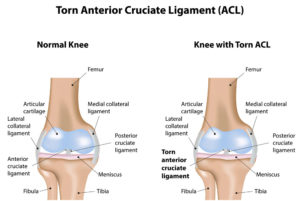Anterior Cruciate Ligament (ACL) Tear Specialist

Are you an athlete who participates in sports that involve jumping or quick stopping? If so, you may be at risk of tearing your anterior cruciate ligament, or ACL. An ACL tear is one of the most common injuries suffered by athletes. ACL tear specialist, Dr. Jervis Yau provides diagnosis and both surgical and nonsurgical treatment options for patients in Santa Barbara who have suffered a torn ACL. Contact Dr. Yau’s team today!
What is an ACL Tear?
The anterior cruciate ligament (ACL) runs through the knee from the front of the tibia (shinbone) to the back of the femur (thighbone) and is considered the main stabilizing ligament. The ACL is responsible for providing proper knee movement and preventing knee instability while performing athletic, work and everyday activities. An anterior cruciate ligament injury is common in the active population. An injury to the ACL can range from a mild sprain to a complete ACL tear. Dr. Jervis Yau, orthopedic knee specialist, specializes in diagnosing and treating ACL injuries in order to return Santa Barbara, Goleta, Santa Maria and Ventura, California patients to the activities they enjoy.
The ACL plays an important role within the knee joint by maintaining knee stability and providing protection to the two menisci of the knee. ACL injuries are commonly seen in sports such as skiing, football, basketball, soccer, tennis and gymnastics. ACL tears are typically a result of abnormal knee pivoting or twisting with the foot planted, but sometimes can occur from a direct blow. If not completely torn, the ACL can be stretched beyond its normal range, resulting in laxity of the ligament and persistent instability.
What are the Symptoms of an ACL Tear?
The symptoms of acute anterior cruciate ligament injury are pain, swelling, and stiffness of the knee joint. After the initial injury calms down, the most common complaint is that the knee buckles or shifts with certain movements (instability). Symptoms vary based on injury severity. A mild sprain may cause pain with limited swelling, while a severe ACL tear may cause a “popping” sound or sensation followed by significant swelling, pain and the inability to bear weight.
How are ACL Tears Diagnosed?
Dr. Yau will perform a complete medical review and physical examination to assess the injury severity and determine the level of knee instability. X-rays are commonly performed to rule out fractures, osteoarthritis and other potential knee injuries. Dr. Yau commonly recommends a MRI scan to confirm the diagnosis and evaluate for concomitant injuries.
How is an ACL Tear Treated?
Not all patients who experience an anterior cruciate ligament injury require surgical intervention. The severity and symptoms of the ACL tear will determine the proper treatment plan. ACL injuries are typically graded from a scale of 1 to 3 based on progressive severity.
- Grade 1: 3-5mm translation representing mild sprain
- Grade 2: 5-10mm translation representing partial or complete ACL tear
- Grade 3: >10mm translation representing complete ACL tear and/or other ligamentous injury
Non-Surgical
If an injury to the ACL does not involve significant knee instability, Dr. Yau will recommend rest, ice, elevation and anti-inflammatory medications followed by physical therapy to restore function.
Surgical
A complete ACL tear will typically require surgical intervention to restore normal knee function. Dr. Yau performs arthroscopic assisted ACL reconstruction by removing the damaged ligament and replacing it with a new tissue, called the graft. Dr. Yau will strive to use the patient’s own tendons for the graft, which is known as an autograft. This is because the patient’s own tissue heals faster and reduces the risks associated with a cadaver tendon graft (allograft). However, allografts may be good options in certain patients and those who had previous knee injuries or surgeries that do not have adequate tendons to take for grafting.
For additional resources on an anterior cruciate ligament injury, or to determine if you require surgery for your ACL tear, please contact Dr. Jervis Yau, orthopedic knee specialist in the Santa Barbara, Goleta, Santa Maria and Ventura, California area.
ACL Injury FAQ
1. What does an ACL tear feel like?
The pain from an anterior cruciate ligament (ACL) tear is sudden and often severe, accompanied by a snap or audible pop when an injury happens. Often it results from a twisting action (in a sport such as football, basketball, tennis or soccer), where the foot is planted on the ground and the knee is turned inward (also known as “plant and pivot”). Swelling may occur within a few hours of the injury. In some cases, the knee might buckle, or give out when weight is applied.
2. How do ACL tears happen?
The most common cause of an ACL tear is during athletic activity. These injuries are especially common in contact sports such as football, soccer, basketball, mixed martial arts, but also a recreational activity like downhill skiing. Sport that combine planting the foot followed by a fast pivot or change in direction can lead to a torn ACL, as the knee is forcefully twisted or hyperextended.
When an ACL injury occurs, the tear can be mild or severe. A complete rupture, or tear, of the ligament involves a separation of the ligament from the upper or lower leg bone or a separation of the ligament and part of the bone from the rest of the bone. When this happens, the bone in the lower leg moves abnormally forward on the upper bone, which is what makes the knee seem to “give out” or buckle.
3. Are ACL Tears common?
ACL tears are common. Our bodies were not anatomically built to leap and “cut” from side to side. The force created by performing side-to-side movements stresses the ACL by pushing the tibia (the shinbone) out of position. And the ACL’s main job is to prevent the tibia from moving in front of the femur and out of the joint. It’s essentially a tough band of tissue that connects the two bones (tibia and femur) and helps stabilize and coordinate motion. If someone makes an awkward motion while planting his or her foot, the ACL may be strained.
4. Why doesn’t the ACL heal on its own?
There are several reasons why the ACL does not heal on its own. Blood supply to the torn ligament is poor, which slows the healing process. With a torn ACL, the flow of synovial fluid prevents the formation of the blood to clot. The blood is then dispersed in the knee joint, failing to form a temporary structural support. Without temporary support, the torn ACL doesn’t receive the proteins or other substances that, through blood flow, are needed to heal properly.
5. How does the ACL work?
The anterior cruciate ligament, commonly known as the ACL, serves several important roles. The main role of the ACL is to keep the knee stabilized. It attaches the thigh bone (femur) to the shin bone (tibia) and keeps the shin bone from moving too far forward. It prevents excessive internal rotation of the shin bone and keeps the knee from hyperextending. When someone falls or lands a jump and makes a sudden change in running direction, the ACL can be sprained or torn.
6. When should I have ACL surgery after an injury?
If the knee is left untreated after an ACL injury, the knee may have long-term problems with stability, in other words it may continue to buckle or give out particularly when engaged in sports that require pivoting (such as football, soccer and basketball). The severity of the ACL injury will determine the right course of treatment. In more mild ACL injuries, initially treatment will focus on addressing the pain and swelling. When those subside and mobility improves, the person may walk more normally and might want to return to athletic activities.
If the ACL is completely torn, the ligament will not heal properly. In most cases, Dr. Yau will recommend surgical treatment of a completely torn ACL for those who wish to return to full activity.
The arguments in favor of having ACL reconstruction surgery:
- The ability to return to playing sports that require a fully functioning ACL
- Return stability to knee
- It may offer protection from damage to the knee cartilage
